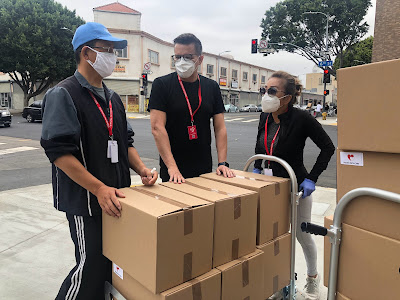Introduction to BrainDrop
Both the delivery technique and the shipping pallet are not typical. The Brightdrop ep1e pallet is a component of a connected and electrified delivery environment.
With the precise management tools you want, Brightdrop enables you to carry goods from the warehouse shelf to the retail shelf and all the way to your front door. Brightdrop is designed to assist eliminate touch errors, labor expenditures, and physical strain on your workers.
Fleet and mobile asset management technologies keep track of every Bradshaw product, from ideas that transport items over modest distances to quick loading bands powered by a battery platform in the end. By enabling effective deliveries supported by reliable support services, Brightdrop has been developed to assist minimize the total cost of ownership, maximize productivity, increase safety, and reduce your carbon footprint.
Brightdrop is a comprehensive ecosystem that can help you change the way you provide products and services.
The Experience of BrainDrop
In order to provide us a glimpse into the future of this unfinished planet of ours, a thought-provoking display has been developed. Let's go forward in time. What are the plans for Friday? New activities and new approaches are required. It was just so enjoyable. Yes, the large side and windshield allow you to view everything. Just the fact that the primary safety is accelerated is impressive. The time has come. The future world is a stunning place.
Make last-mile delivery employees in the US and Europe feel more human.
General Motors recently launched Rydrov, a venture that will concentrate on delivery as an ecosystem. Rydrov is collaborating closely with the larger GM organization to bring electrical vehicles that are specifically designed for last-mile delivery—think of everything it takes to get packages to your home or place of business.
the things to which we have grown accustomed as well as small electric carts, or "traces," which are electrically propelled devices that essentially drastically alter the sort of human requirements of the job and all the software necessary to deploy those in order to tightly integrate it into a complete system.
As you can imagine, having a company that excels at creating and testing things at scale gives our vehicles a tonne of credibility, and we've already started deploying them in the field within a year of their announcement. As a result, we find ourselves in an honorable position thanks to our partnership with General Motors.
The reason we've been established as a different company is that we're approaching the market with a much broader perspective than just the vehicle alone. The Evo 600 van is our entry vehicle and was chosen to launch with so that it did have that sort of wide appeal and is a very important mechanism for an electric vehicle. It has 600 cubic feet of cargo space, which equates to about 17 cubic meters.
And it actually satisfies modern requirements, but we didn't stop there. We thoroughly investigated what would work best for the driver, and what would work best for the fleet management, and there are thousands of touch points. Whether it's the vehicle's having to step height, the location of cup holders, the tendency of a bulkhead, or what it indicates to have that step-in van experience, it's important to consider these factors because the jobs in question require drivers to make upwards of 150 stops daily in the US while only 90 stops are typical in Europe.
And we are really trying to humanize this really monotonous workload here. Deployments are still in their early stages. In the field are our automobiles. Since the delivery of Christmas gifts in December of last year, they have been working long hours on a somewhat regular basis. We recently even had the chance to speak with them and observe how the drivers were responding. Even when we encountered difficulties, we still received a really favorable response to them.
In plenty of other words, the response has been overwhelmingly favorable and we are extremely pleased with the team since our engineering teams were able to develop and deliver software patches. This program was put developed in a speedy manner. Within a year of announcing it, we were able to deliver vehicles.
Regarding the track, you asked. We were able to test out a few pilots pretty early on, and the outcomes were amazing. The very first observations were that we were able to decrease in densely populated urban locations, like New York, when this gadget is installed in current vehicles.
A 50 percent reduction in the curve time—the time the vehicle spends dumping packages—represents a significant performance increase. The efficiency improvement overall was 25, which in our industry is pretty much unheard of for a single adjustment, and these were then picked up by runners who could then quickly deploy them to their ultimate destination.
Because of this, we are not just decarbonizing but also increasing efficiency, and we currently have a lot of momentum that will allow us to grow on this.
The mission is much broader for us in our decarbonization challenge, so we'll keep looking for ways to build a better, more customized experience in the vehicle and be able to make that vehicle sort of the facilities operated on the edge as well as the emission-free vehicle that gets you from point a to point b.
I believe that the current lack of supply is where it all starts. We are in the fortunate position of having people set incredibly ambitious decarbonization targets in response to the kind of society we live in. We will be able to increase our production and satisfy that demand thanks to GM's support. The current infrastructure for charging will be the next obstacle.
Researchers are learning a great deal from our early deployments, as are our partners and release partners. We will also be able to use the larger GM ecosystem to bring comprehensive infrastructure services so that our customers can really thrive in modernization and see the benefits from both a total cost of ownership and condensed logistics point of view. I join because I want to be a part of the change. Today, I experience that a lot.
The network is exercising its muscles in ways they were never intended to due to the expansion in demand and the constant upgrading of customer expectations. For us, I believe the potential to develop a more effective method of delivery where you can accomplish more with less comes first. Better customer experiences can be achieved without necessarily increasing the number of vehicles on the highway.
However, we are also acutely aware of the pressures facing the labor force, and we believe that technology has enormous potential in this area. With things like electrically shielded gadgets and self-driving technologies being used in this field responsibly, we see a big opportunity to create a more human profession, and we're really enthusiastic about what we can provide as a system to the market.
By BrightDrop, electric delivery carts have been modified.
Two electric vans and one electric delivery cart now go by the moniker Bright Drop, a General Motors electric delivery van firm. The bright drop ev600, the heavier of the two vans, will be referred to as the bright drop zevo 600, and the EV-410, as the bright drop zevo 400.
GM claims that the zevo 600 van is appropriate for long-distance distribution and has a load-bearing capacity of 600 cubic feet. On a built-in rechargeable, it has a range of up to 250 miles. The Ziva 400 van is perfect for smaller, more frequent deliveries like supermarket deliveries and telecom repair because it has a cargo space of more than 400 cubic feet. The new name for the Bright Drop electricity palette is the words "trace and e-card" reversed. It was formerly known as Ep1. From the delivery van to the customer's door, the trail brings the products to you.







_11zon.png)

No comments:
Post a Comment